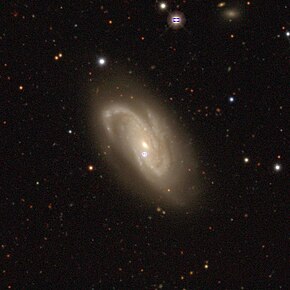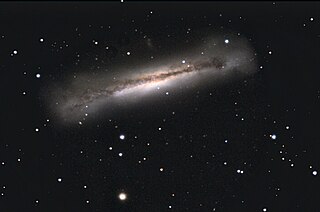
NGC 3628, also known as the Hamburger Galaxy or Sarah's Galaxy, is an unbarred spiral galaxy about 35 million light-years away in the constellation Leo. It was discovered by William Herschel in 1784. It has an approximately 300,000 light-years long tidal tail. Along with M65 and M66, NGC 3628 forms the Leo Triplet, a small group of galaxies. Its most conspicuous feature is the broad and obscuring band of dust located along the outer edge of its spiral arms, effectively transecting the galaxy to the view from Earth.

NGC 2 is an intermediate spiral galaxy with the morphological type of Sab, located in the constellation of Pegasus. NGC 2 was discovered by Lawrence Parsons, 4th Earl of Rosse on 20 August 1873."

NGC 6744 is an intermediate spiral galaxy about 30 million light-years away in the constellation Pavo (Peacock). It is considered as a Milky Way mimic in the immediate vicinity, displaying flocculent (fluffy) arms and an elongated core. It also has at least one distorted companion galaxy superficially similar to one of the Magellanic Clouds. It was discovered from Parramatta in Australia by Scottish astronomer James Dunlop on 30 June 1826.
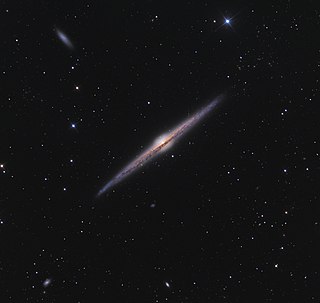
NGC 4565 is an edge-on spiral galaxy about 30 to 50 million light-years away in the constellation Coma Berenices. It lies close to the North Galactic Pole and has a visual magnitude of approximately 10. It is known as the Needle Galaxy for its narrow profile. First recorded in 1785 by William Herschel, it is a prominent example of an edge-on spiral galaxy.
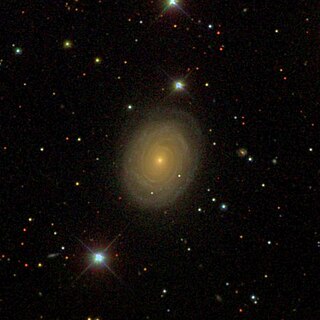
NGC 7001 is an intermediate spiral galaxy located about 300 million light-years away in the constellation Aquarius. NGC 7001 has an estimated diameter of 106,000 light-years. It was discovered by English astronomer John Herschel on July 21, 1827, and was also observed by Austrian astronomer Rudolf Spitaler on September 26, 1891.

NGC 480 is a spiral galaxy located about 546 million light-years away from Earth in the constellation Cetus. NGC 480 was discovered by American astronomer Francis Leavenworth In 1886.

NGC 7038 is an intermediate spiral galaxy located about 210 million light-years away in the constellation of Indus. Astronomer John Herschel discovered NGC 7038 on September 30, 1834.

NGC 7047 is an intermediate spiral galaxy located about 270 million light-years away in the constellation of Aquarius. NGC 7047 is also classified as a LINER-type galaxy. NGC 7047 has an estimated diameter of 127,350 light years. It was discovered by French astronomer Édouard Stephan on August 20, 1873. In 2009 a supernova was found in NGC 7047.
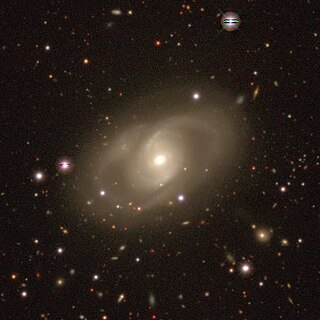
NGC 7060 is an intermediate spiral galaxy located about 200 million light-years away in the constellation of Microscopium. The spiral arms of NGC 7060 appear to overlap. NGC 7060 was discovered by astronomer John Herschel on September 2, 1836.
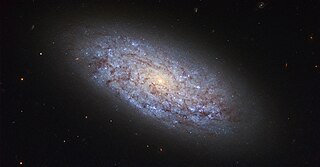
NGC 5949 is a dwarf spiral galaxy located around 44 million light-years away in the constellation Draco. NGC 5949 was discovered in 1801 by William Herschel, and it is 30,000 light-years across. NGC 5949 is not known to have an Active galactic nucleus, and it is not known for much star-formation.

NGC 5774 is an intermediate spiral galaxy approximately 71 million light-years away from Earth in the constellation of Virgo. It was discovered by Irish engineer Bindon Stoney on April 26, 1851.

NGC 4540 is a spiral galaxy with type 1 Seyfert activity located about 64 million light-years away in the constellation Coma Berenices. NGC 4540 was discovered by astronomer William Herschel on March 21, 1784 and is a member of the Virgo Cluster.

NGC 6040 is a spiral galaxy located about 550 million light-years away in the constellation Hercules. NGC 6040 was discovered by astronomer Édouard Stephan on June 27, 1870. NGC 6040 is interacting with the lenticular galaxy PGC 56942. As a result of this interaction, NGC 6040's southern spiral arm has been warped in the direction toward PGC 56942. NGC 6040 and PGC 56942 are both members of the Hercules Cluster.

NGC 521, also occasionally referred to as PGC 5190 or UGC 962, is a barred spiral galaxy located approximately 224 million light-years from the Solar System in the constellation Cetus. It was discovered on 8 October 1785 by astronomer William Herschel.

NGC 4299 is a featureless spiral galaxy located about 55 million light-years away in the constellation Virgo. It was discovered by astronomer William Herschel on March 15, 1784 and is a member of the Virgo Cluster.

NGC 4305 is a dwarf spiral galaxy located about 100 million light-years away in the constellation Virgo. The galaxy was discovered by astronomer John Herschel on May 2, 1829. Although considered to be a member of the Virgo Cluster, its high radial velocity and blue luminosity suggest it is in fact a background galaxy. The galaxy has a nearby major companion; NGC 4306.

NGC 4313 is an edge-on spiral galaxy located about 50 million light-years away in the constellation Virgo. It was discovered by astronomer William Herschel on March 15, 1784. NGC 4313 is a member of the Virgo Cluster and is classified as LINER and as a Seyfert galaxy.
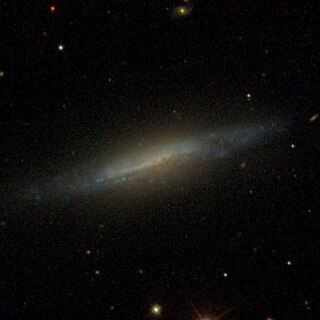
NGC 4359 is a dwarf barred spiral galaxy seen edge-on that is about 56 million light-years away in the constellation Coma Berenices. It was discovered by astronomer William Herschel on March 20, 1787. It is a member of the NGC 4274 Group, which is part of the Coma I Group or Cloud.
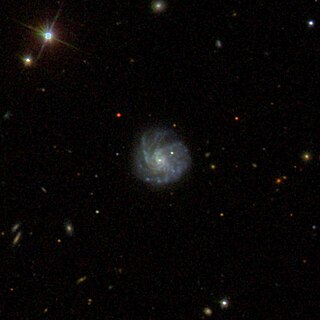
NGC 3678 is a spiral galaxy located around 361 million light-years away in the constellation Leo. NGC 3678 was discovered on April 13th, 1831 by the astronomer John Herschel, and its diameter is 127,000 light-years across. NGC 3678 is not know to have much star-formation, and it is not know to have an active galactic nucleus.

NGC 4825 is a lenticular galaxy located around 230 million light-years away in the constellation Virgo. NGC 4825 was discovered on March 27th, 1786 by the astronomer William Herschel, and its diameter is 133,000 light-years across. NGC 4825 is not know to have much star-formation, and it does not have an active galactic nucleus.
